Overcoming FM challenges with Automated Facility Management Systems
The facility management landscape is evolving, and let's be honest, the old ways of doing things just aren't cutting it anymore. We're constantly putting out fires instead of preventing them, struggling to get a clear picture of what's going on due to disconnected systems, and drowning in a sea of paperwork.
It's inefficient, it's unproductive, and frankly, it's just plain exhausting. It's time to ditch the old way and embrace a smarter approach to facility management.
Enter Automated Facility Management Systems (AFMS) – your one-way ticket to operational efficiency. AFMS goes beyond traditional computer-aided facility management (CAFM) software or building maintenance software, acting as a one-stop solution for managing your building operations.
Think of it as your trusty co-pilot, taking care of the tedious tasks and empowering you to focus on what really matters – making your facilities shine. With AFMS, you can finally escape the reactive maintenance trap, bridge the gaps created by siloed systems, and leave the burden of paperwork behind.
As highlighted in a Forbes article, the goal of FM automation is to reliably streamline the workflow, so you can concentrate on improving your business while it’s seamlessly running in the background. It gives real-time insights, and helps make data-driven decisions that optimize your facility's performance. So buckle up and get ready to experience the future of facility management.
What is automated facility management?
Before we dive deeper into the benefits and features, let's get clear on what we mean by Automated Facility Management (AFMS). Simply put, it is the use of technology to streamline and automate tasks within facility operations.
Automation technologies used today are built to handle all operations from work order management and preventive maintenance to enterprise asset tracking, energy management, and occupant engagement.
Think of it as having a tireless digital assistant that takes care of the repetitive, time-consuming tasks, freeing you and your team to focus on the strategic, big-picture aspects of facility management.
Beware of Superficial Automation: A Wolf in Sheep's Clothing
Not all automation is created equal. There's a sneaky trap lurking out there called "superficial automation," and we need to be aware of it. This happens when organizations try to implement a system for facility management by simply layering point solutions to patch up the shortcomings of legacy CMMS systems, creating Frankenstein's monster of disconnected tools and processes.
It's like putting a band-aid on a broken leg – it might look like a solution on the surface, but it doesn't address the underlying problem.
The danger of superficial automation is that it can lull us into a false sense of security. We might think we're on the path to progress, but in reality, we're just creating a more complex and fragmented system that hinders our ability to truly optimize facility operations.
Key benefits of AFMS
Ready to ditch the headaches and unlock the true potential of your facilities? Let's explore the key benefits of embracing a comprehensive Automated Facility Management System (AFMS):
Enhanced productivity and operational efficiency
Imagine this: your team effortlessly manages work orders, schedules preventive maintenance like clockwork, and tracks assets with pinpoint accuracy – all without breaking a sweat. An automated facilities management system sets those tedious, repetitive tasks that drain time and energy on autopilot, freeing your staff to focus on higher-value activities that truly impact your facility's performance.
- Streamlined workflows: Say goodbye to manual data entry, lost paperwork, and endless email chains. Maintenance workflow automation creates a seamless flow of information, automating tasks and keeping everyone on the same page, leading to better management of facilities.
- Empowered teams: When your team isn't bogged down by mundane tasks, they can focus on what they do best – solving problems, innovating, and delivering exceptional facilities services.
- Time saved: Automation saves time, pure and simple. This means faster response times, quicker turnaround on tasks, and more time for your team to focus on strategic initiatives.
Reduced costs and increased ROI
Let's talk about the bottom line. AFMS isn't just about making things easier; it's about making them more cost-effective. By optimizing workflows, reducing energy consumption, and extending the life of your assets, facility automation delivers a significant return on investment (ROI) with substantial cost savings across various areas.
- Proactive maintenance: By identifying and addressing potential issues before they become costly problems, you'll save on reactive repairs, downtime, and equipment replacements. This proactive maintenance approach is essential for building maintenance and ensuring the longevity of your facility assets.
- Energy efficiency: Buildings are energy guzzlers responsible for a whopping 40% of global energy consumption. Automated FM systems equip you with real-time data on your energy consumption patterns. Imagine smart thermostats adjusting to occupancy, or lights automatically dimming in unused areas. This granular control increases your energy efficiency, significantly reducing your carbon footprint and utility bills.
- Maximized asset value: With proper maintenance and care, your assets will last longer, saving you the expense of premature replacements.

Elevated occupant experiences
Happy occupants are the cornerstone of successful facilities. AFMS helps you create a positive and productive environment that fosters occupant engagement, satisfaction, and well-being.
- Faster response times: An automated facilities ticketing system ensures prompt responses and efficient resolution of issues, keeping occupants happy and productive.
- Clear communication: Keep occupants informed and engaged with automated notifications, updates, and self-service portals that empower them to take an active role in their environment.
- Proactive problem-solving: AFMS helps you identify and address potential issues before they impact occupants, creating a seamless and positive experience.
Data-driven decision making
Automated maintenance and management puts the power of data at your fingertips, providing real-time insights and analytics that enable you to make informed decisions and optimize your facility's performance.
This data-driven approach can be crucial for effective property management and real estate management.
- Measure what matters: Track key performance indicators (KPIs) of maintenance programs, identify trends, and gain a comprehensive understanding of your facility's operations.
- Predictive power: Leverage AI in facilities management and machine learning to predict potential issues, optimize maintenance schedules, and make data-driven decisions that prevent problems before they arise.
- Strategic planning made easy: With accurate data and clear insights, you can make informed decisions about resource allocation, budget planning, and long-term facility management strategies.
Sustainability and compliance
AFMS empowers you to achieve your sustainability goals and ensure compliance with regulations, all while improving operational efficiency. This is essential for both corporate facility management and industrial facility management.
- Reduce your environmental impact: Optimize energy consumption, minimize waste, and implement sustainable practices that benefit both your facility and the planet.
- Stay ahead of regulations: Automated management helps you track and manage compliance documentation, ensuring you meet all regulatory requirements and avoid costly fines.
- Transparency and accountability: Gain clear visibility into your facility's environmental impact and demonstrate your commitment to sustainability.
By implementing AFMS, you're not just adopting a new technology; you're unlocking a new era of operational excellence for your facilities. It's time to ditch the old ways of doing things and step into the future of facility management.
Key features of an AFMS
We've established that AFMS is the way to go for modern facility management. But what exactly should you look for when choosing the right system? Let's break down the essential features that will empower you to conquer your facility management challenges:
Centralized work order management
Remember the days of drowning in a sea of work orders, struggling to keep track of progress, and feeling like you're constantly putting out fires? Those days are over with a robust work order management system.
Imagine having a centralized platform where you can effortlessly create, assign, track, and complete work orders with automated notifications and escalations.
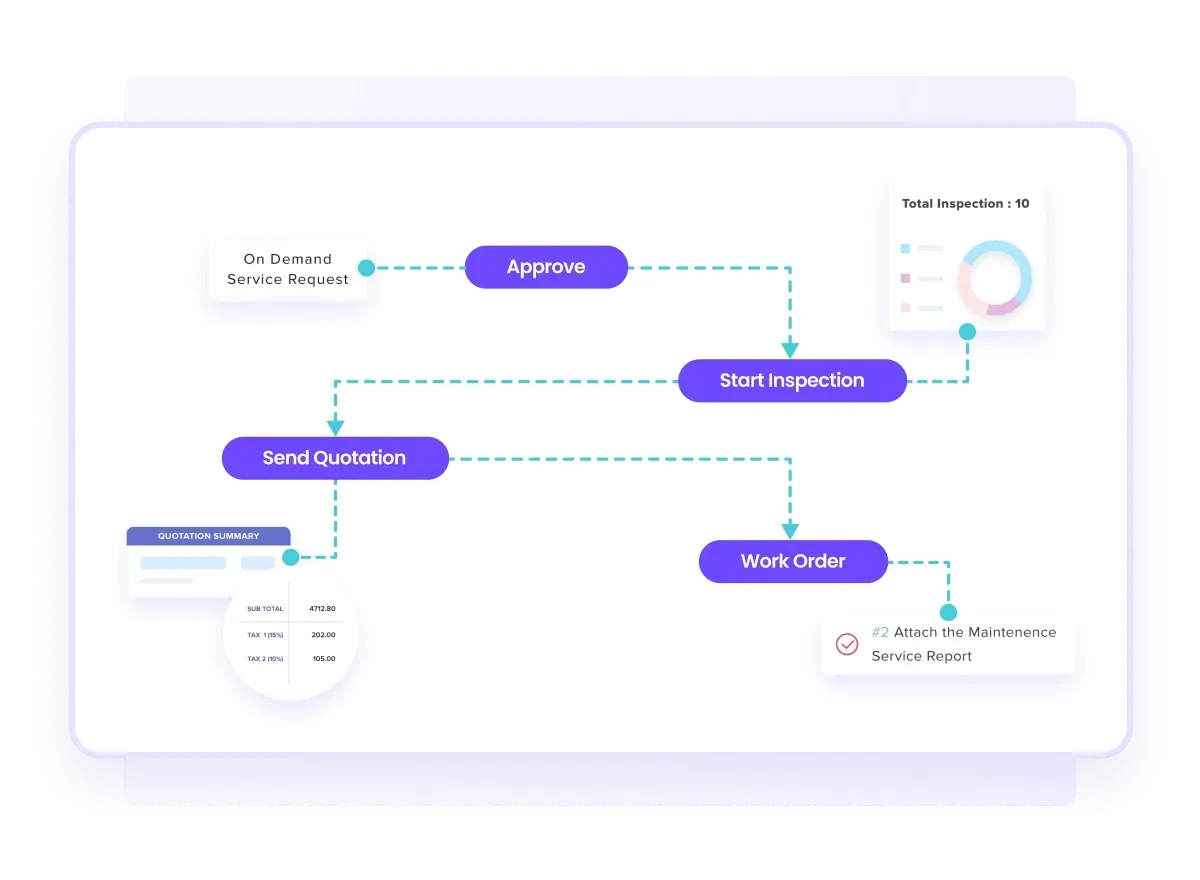
Take Al Tayer, a company based in UAE, spanning automotive, retail, and real estate sectors, as an example. They were facing challenges with managing their long-term assets and lacked the data-driven insights needed for effective decision-making.
By implementing Facilio's work order management system, they gained real-time visibility into asset performance and streamlined their maintenance operations.
As their facilities manager put it,
"The biggest success is that we control the data. These are assets that last 50-60 years. We can now look after them for that long and plan for them effectively."
Suggested read: Top 10 work order management software (2024)
Preventive maintenance
Tired of the reactive maintenance hamster wheel? It's time to shift gears and adopt a proactive approach that is essential for any building management system or maintenance management software.
A powerful AFMS will allow you to schedule and track preventive maintenance tasks like clockwork, ensuring your equipment runs smoothly and avoiding costly breakdowns.
Tuten Labs, a retail company was struggling with manual work order management. They were bogged down by inefficient processes and slow response times. But with Facilio's platform, they were able to automate critical operational processes, including generating work orders directly from alerts.
This led to quicker response times and a standardized approach to managing maintenance tasks. As Roi Amszynowski, CEO of Tutenlabs, said,
"Working with Facilio is much more than using a new piece of software; it means consolidating a one-in-a-kind value proposition to transform the facility management industry…"
Synchronized asset management
Your assets are the lifeblood of your facility. With a comprehensive and synchronized asset management system, you can track the location, condition, and performance history of every piece of equipment, ensuring optimal utilization and extending its lifespan.
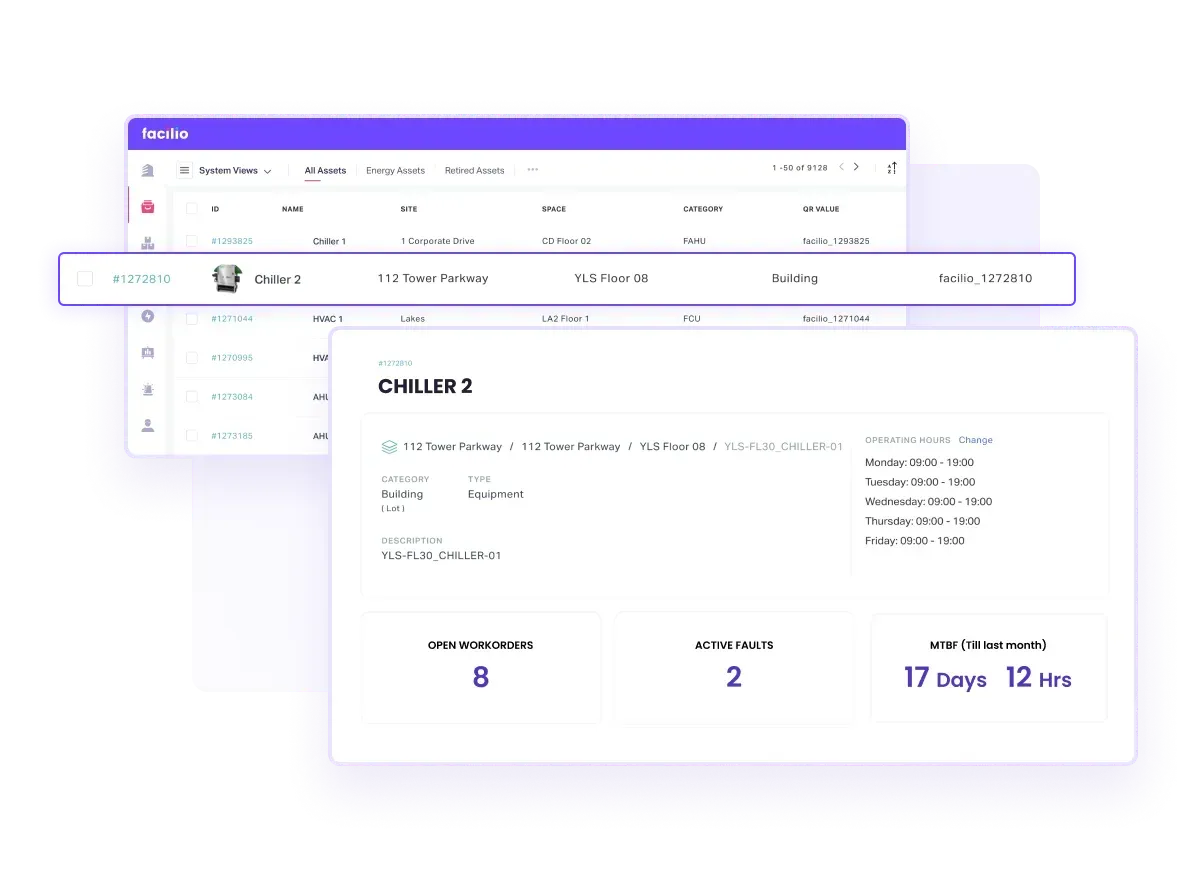
Investa, a commercial office in Australia, faced challenges with managing their vendors and tracking invoices. With Facilio's integrated platform, they were able to synchronize data across modules, simplifying vendor management and gaining clear visibility into payment cycles. Their General Manager of Facilities Services noted,
"With Facilio, we no longer need to…[manually track records]. Now, vendors add them to the work orders itself. It also ensures accurate payment tracking. We have clear visibility into the near-term and long-term future."
Suggested read: CMMS asset management: Key functionalities and Software
Mobile accessibility
In today's fast-paced world, being tied to a desk is no longer an option. A mobile-friendly AFMS empowers your team to manage work orders, access asset information, and stay connected on the go.
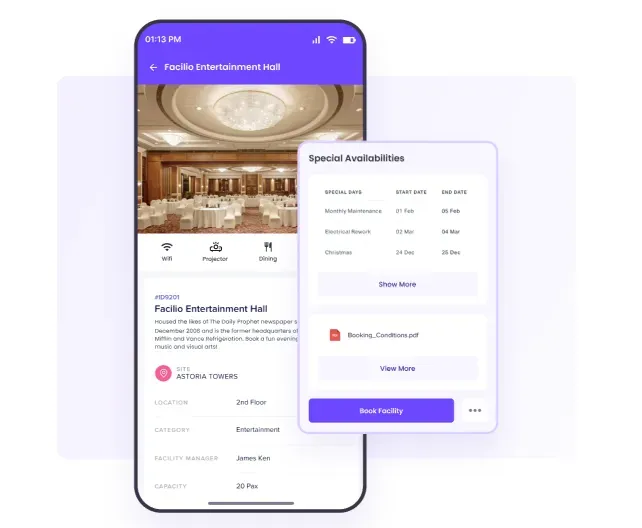
Quality FM, one of the top facilities service providers in UAE, experienced significant optimization by utilizing Facilio's contextual mobile work orders. These mobile orders provided staff with valuable insights into asset maintenance history, saving time and effort.
As Operations Manager Sumith Sukumaran stated,
"Facilio's integrated solution suite helps our stakeholders make data-led operational decisions to deliver continuous value to our customers."
IoT integration for real-time monitoring
Integrating Internet of Things (IoT) technology in facilities management platform can revolutionize the way you manage your buildings. Imagine real-time data streaming from your assets, providing insights into equipment performance, energy consumption, and occupant comfort.
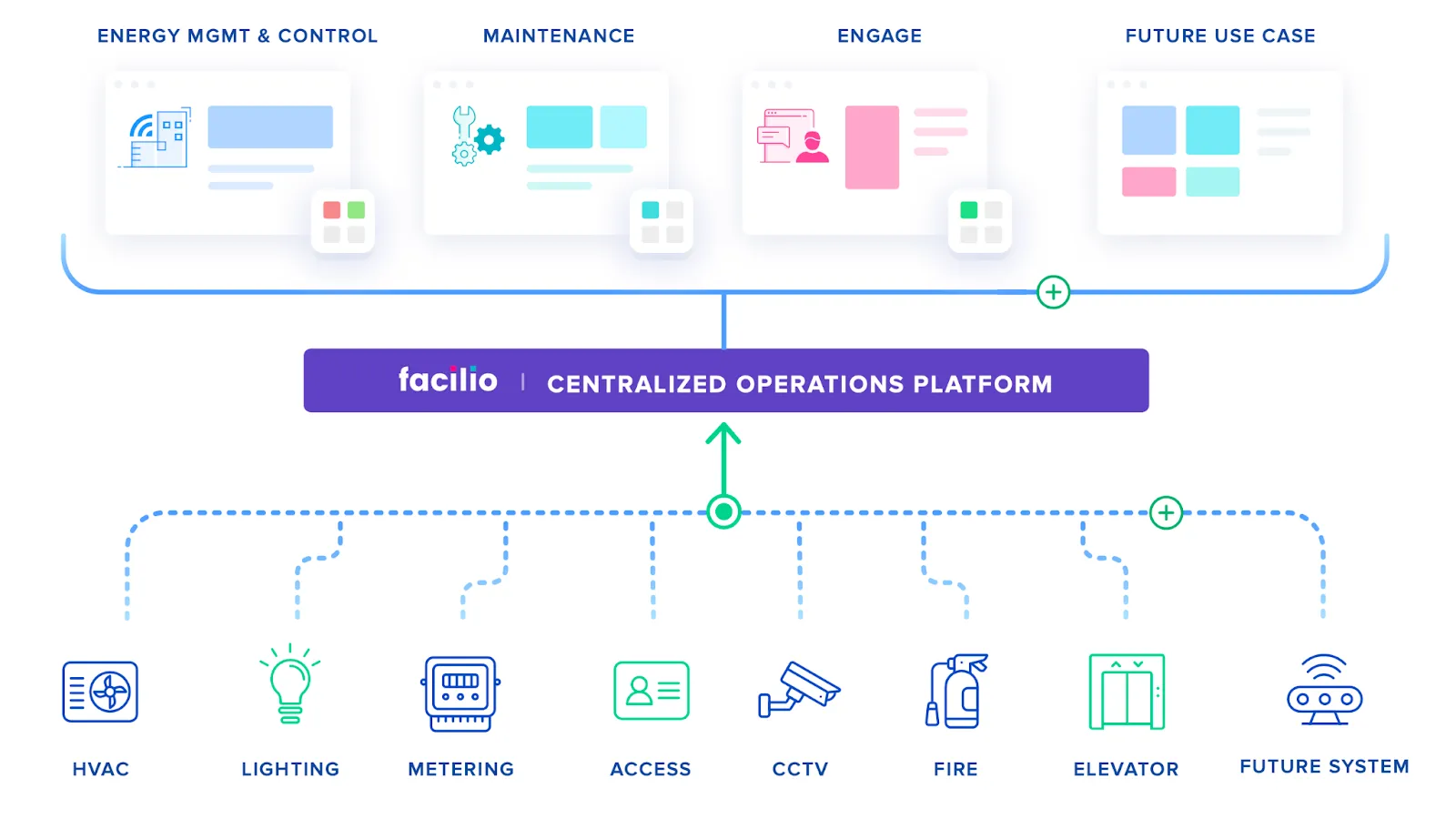
Facilio's IoT solution seamlessly connects with your existing Building Automation Systems (BAS) and Building Management Systems (BMS), regardless of brand or protocol. It allows you to connect and stream performance data from your building systems in real-time, giving valuable insights into your facility's operations.
Not only can you collect data, but you can also control your building systems remotely, adjusting setpoints and optimizing performance.
With Facilio, you can aggregate data onto a single platform for advanced analytics, visualization, and machine learning models, enabling you to make informed decisions and optimize your portfolio-wide operations.
Advanced reporting and analytics
Knowledge is power, and automation technologies put that power in your hands. Advanced reporting and analytics capabilities provide you with actionable insights into your facility's performance, empowering you to make data-driven decisions and optimize operations.
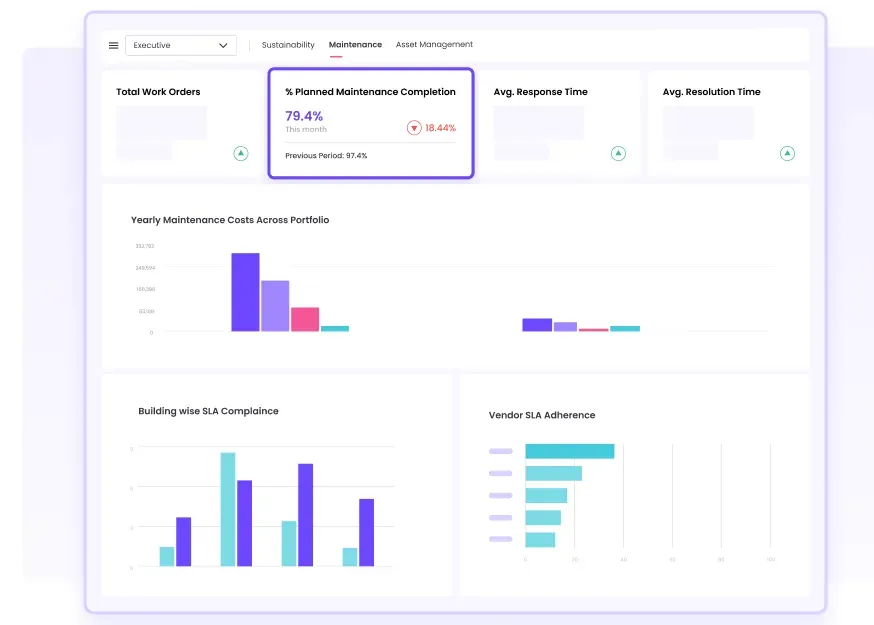
Consider CIT Ltd, a company based in Saudi Arabia, specializing in managing national landmarks and cities. They faced significant challenges with their facilities management, including the lack of a unified CMMS and an inability to effectively document workforce attendance.
Facilio provided the solution with a connected CMMS solution, implemented in a record time of 2 weeks.
With Facilio, CIT gained a digital view of their PM calendar, facilitating automated work orders and streamlining management. CIT leveraged Facilio's analytical dashboards to monitor activities, including PPM, reactive maintenance, pending work orders, and overall statuses.
The platform also automated daily and weekly reports, delivering them directly to stakeholders’ inboxes, enabling swift issue resolution and efficient communication.
The result? CIT Ltd. achieved threshold-based automated work orders, reduced manual intervention, gained portfolio-level visibility, and a centralized repository of assets.
Suggested read: Automated Reporting: Turn your data into actionable insights
Smart building technology
According to the International Energy Agency (IEA), the primary energy consumers in buildings are HVAC systems that consume 40% of the total building energy.
Integrating smart building systems allows for automated control of lighting, HVAC, and other environmental factors, creating a comfortable and energy-efficient environment for occupants.
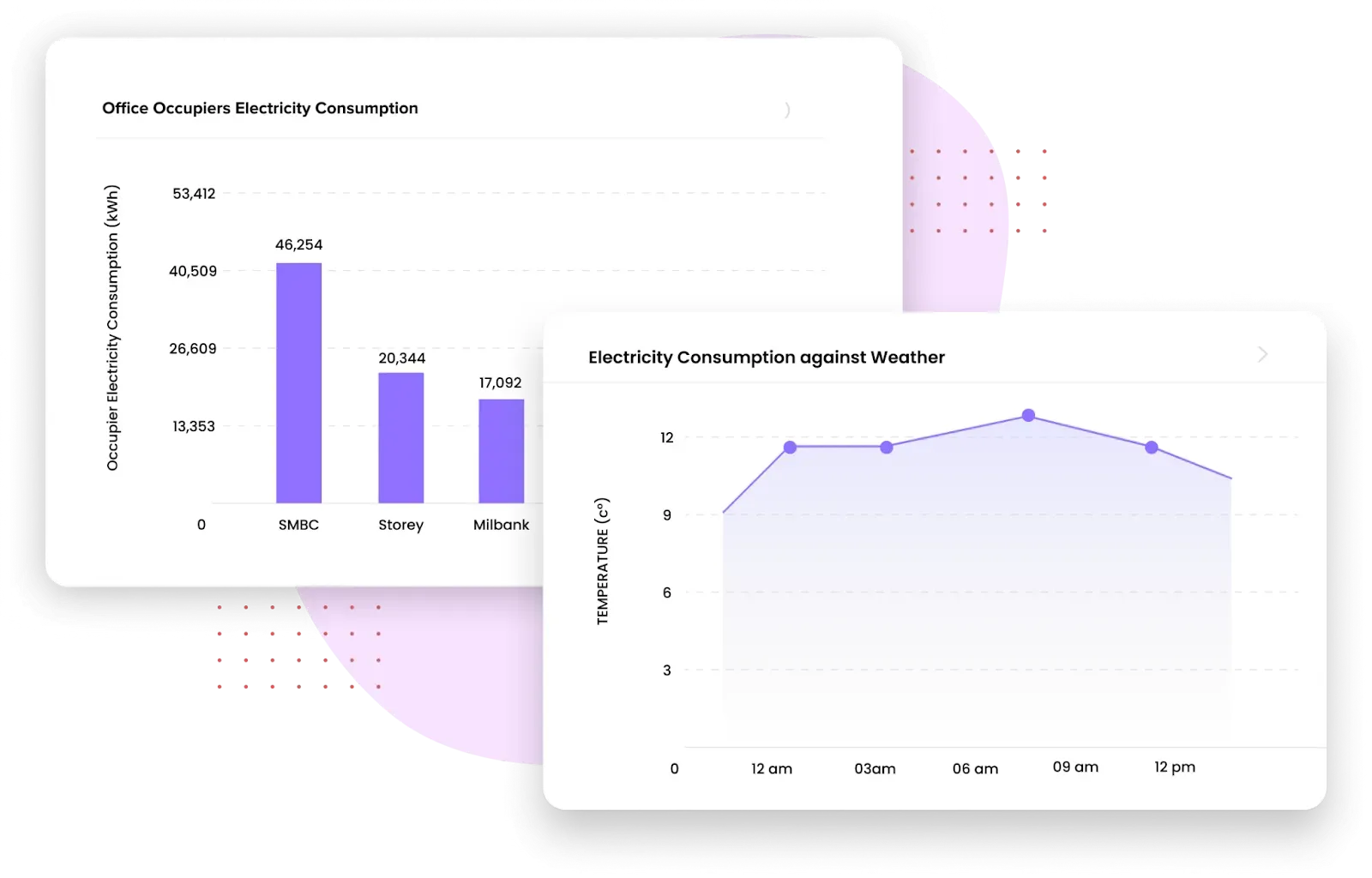
For example, the University of Melbourne, a renowned institution in Australia with a commitment to sustainability, wanted to reduce its energy consumption and achieve greater operational efficiency across its expansive campus. Facilio’s Connected Buildings platform provided the solution.
By leveraging the power of IoT and advanced analytics, the university gained real-time visibility into energy consumption patterns, enabling them to optimize building performance and make data-driven decisions.
Optimized HVAC operations based on occupancy and real-time data ensured consistent temperature control and improved air quality, boosting occupant comfort and productivity. With Facilio’s smart building technology, the University of Melbourne achieved significant progress toward its sustainability goals while enhancing occupant comfort and optimizing building performance.
By choosing an AFMS with these essential features, you're setting yourself up for success in the evolving world of facility management. Remember, it's not just about automating tasks; it's about creating a smarter, more efficient, and more sustainable future for your facilities.
Future of facility management: Automation is here to stay
The transformation of facility management is well underway, and it's clear that automation is the driving force behind this evolution. The benefits are undeniable: increased efficiency, reduced costs, improved occupant experiences, data-driven decision-making, and a path towards a more sustainable future.
This shift towards automation is not just a trend; it's an inevitable progression. As technology continues to advance at an unprecedented pace, facility managers who embrace automation will be best positioned to thrive in this dynamic landscape.
However, navigating the world of AFMS can be daunting. With so many options available, it's crucial to choose a system that aligns with your specific needs and goals. Look for a platform that offers a comprehensive suite of features, seamless integrations, and a commitment to innovation.
Facilio’s platform offers a unified approach to facility management, combining powerful automation capabilities with real-time data and analytics. We're committed to empowering facility managers with the tools they need to achieve operational excellence and create a more sustainable future.
Ready to join the automation revolution? Get in touch today and discover how we can help you transform your facility management approach.
FAQs
What is facility management?
Facility management (FM) encompasses all the activities that ensure a building or facility operates smoothly and efficiently. This includes everything from maintaining building systems and equipment (like HVAC, electrical, plumbing, etc.) to managing space utilization, ensuring occupant comfort and safety, and overseeing cleaning and security services. It's about creating a functional, safe, and productive environment for everyone who uses the facility.
What is facility management software?
Facility management software (often referred to as CAFM software or building maintenance solution) is a technology solution that helps facility managers streamline and automate various tasks within their operations. These systems offer tools for managing work orders, scheduling preventive maintenance, tracking assets, analyzing data, managing vendors, and much more. The aim is to improve efficiency, reduce costs, and enhance the overall management of facilities.
What is a CAFM system?
A CAFM system is a software platform that provides tools and functionalities to manage the various aspects of facility operations, enabling greater efficiency, cost savings, and improved decision-making.
What is a facilities ticketing system?
A facilities ticketing system is a component of facility management software (or a standalone solution) that allows occupants to submit requests for services or report issues. These systems help streamline the process of addressing occupant needs and ensure timely resolution.
What is the difference between CAFM and CMMS?
While the terms are often used interchangeably, there's a subtle difference:
Think of CAFM as the umbrella term, with CMMS being a specific component focused on maintenance.
What is an automated facility management system?
An automated facility management system (AFMS) takes facility management software to the next level by incorporating automation and intelligent technologies. AFMS leverages tools like AI, IoT, and machine learning to automate tasks, analyze data, and provide predictive insights, enabling proactive decision-making and optimized operations.
What are automation technologies?
Automation technologies encompass a wide range of tools and techniques that aim to automate tasks, processes, and systems. In the context of facility management, these technologies include:
Artificial Intelligence (AI): Enables systems to learn from data, make predictions, and automate decision-making.
Internet of Things (IoT): Connects devices and systems to collect real-time data, providing insights into facility performance.
Machine Learning (ML): Allows systems to learn from data patterns and improve their performance over time.
Robotic Process Automation (RPA): Automates repetitive tasks and processes, freeing up staff for higher-value activities.
What is the best facility management software?
The "best" software depends on your specific needs and requirements. However, factors to consider when choosing facility management software include:
Features: Does it offer the functionalities you need, such as work order management, preventive maintenance, asset tracking, and reporting?
Integrations: Does it integrate with your existing systems, such as BAS, BMS, and ERP?
Scalability: Can it adapt to your evolving needs as your facility grows?
User Friendliness: Is the interface intuitive and easy for your team to use?
Support: Does the vendor provide reliable customer support and training?
Suggested read: 12 Best CaFM Software in 2024

